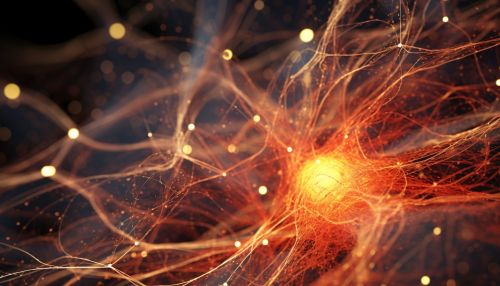Microtubule
Introduction
Microtubules are a component of the cytoskeleton, found throughout the cytoplasm of eukaryotic cells. These tubular polymers of tubulin can grow as long as 25 micrometers and are highly dynamic. The functions of microtubules are critical for cell structure, intracellular transport, and cell division.


Structure
Microtubules are cylindrical tubes of protein, typically found in eukaryotic cell cytoplasm. They are composed of subunits of the protein tubulin, which is a globular protein. Each subunit of tubulin is a heterodimer, consisting of two slightly different polypeptides: alpha-tubulin and beta-tubulin. These tubulin subunits are arranged in a linear fashion to form protofilaments, and 13 protofilaments align parallel to each other to form a microtubule.
Function
Microtubules serve several essential functions in the cell. They are a crucial component of the cytoskeleton, providing a framework for the organization and structure of the cell. Microtubules also play a vital role in intracellular transport, facilitating the movement of vesicles, granules, organelles like mitochondria, and chromosomes via special protein molecules known as motor proteins. Furthermore, they are key players in cell division, forming the mitotic spindle, which is essential for separating chromosomes during mitosis.
Dynamics
Microtubules are dynamic structures, which means they are capable of rapid growth and shrinkage. This dynamic behavior is critical for their biological functions, including cell division, cell motility, and the establishment of cell polarity. The dynamics of microtubules are regulated by the addition and removal of tubulin subunits at the ends of the microtubule, a process known as polymerization and depolymerization, respectively.
Microtubule-Associated Proteins
Microtubule-associated proteins (MAPs) are proteins that interact with the microtubules of the cellular cytoskeleton. They play critical roles in the stabilization of microtubules, the regulation of microtubule dynamics, and the interactions of microtubules with other cellular components. Some MAPs, such as tau and MAP2, are primarily found in neurons and are involved in the development and maintenance of neuronal morphology.
Microtubules in Cell Division
During cell division, microtubules form a specialized structure called the mitotic spindle. This structure is responsible for the segregation of chromosomes into the two daughter cells. The mitotic spindle is formed from two centrosomes, each containing a pair of centrioles, from which microtubules radiate. These microtubules interact with the chromosomes via the kinetochore, a protein complex on the chromosome, and ensure their correct segregation.
Microtubules in Disease
Defects in microtubule function can lead to a variety of diseases. For example, mutations in tubulin genes can lead to neurodevelopmental disorders, collectively known as tubulinopathies. Furthermore, the protein tau, which stabilizes microtubules in neurons, is known to form aggregates in Alzheimer's disease, leading to the destabilization of microtubules and neuronal death. Microtubules are also the target of several chemotherapeutic drugs, which interfere with microtubule dynamics and thus inhibit cell division.
